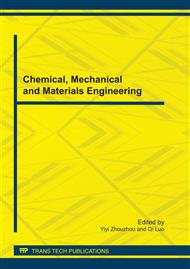p.258
p.264
p.270
p.276
p.282
p.288
p.293
p.298
p.304
Study on the Thermal and Rheological Properties of Reactive Blending PC/PLA/EVA Blends
Abstract:
EVA was added into PC/PLA blends as a modifier for improving the impact strength of blends, and meanwhile the thermal properties and rheological properties of blends should also be influenced. PC/PLA/EVA blends were prepared by melt blending and the catalyst DBTO was added into the blends in blending process to catalyze the transesterification of PC and EVA for improving the compatibility of blends. The effects of blend composition and transesterification on the thermal and rheological properties of blends were investigated. The results showed that the addition of EVA could improve the crystallinity of PLA in PC/PLA/EVA blends but had little influence on the thermal stability of blends,and the transesterification was beneficial to both the crystallization of PLA and thermal stability of blends. The addition of EVA and the transesterification of PC and EVA increased the apparent viscosity of blends, while the apparent viscosity of blends decreased drastically and the pseudo-plasticity characteristic of blend melts was weakened obviously with increasing PLA content and rising temperature.
Info:
Periodical:
Pages:
282-287
Citation:
Online since:
July 2011
Authors:
Keywords:
Price:
Сopyright:
© 2011 Trans Tech Publications Ltd. All Rights Reserved
Share:
Citation:


